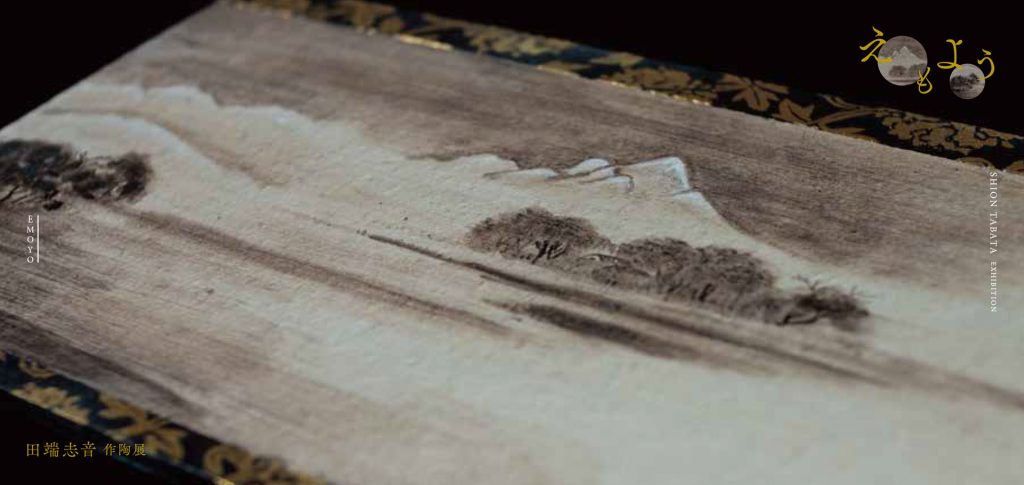2020年11月10日、火曜日より、京都の野村美術館にて田端志音の個展「えもよう」が始まります。
志音の新たな挑戦を、ぜひ会場でご覧ください。
TABATA Shion’s solo exhibition “Emoyo” will start at Nomura Art Museum, Kyoto on Tuesday, November 10, 2020.
Please come and see Shion’s brave new works at the venue.

会場|野村美術館 地下1階
京都市左京区南禅寺河原町61
075-751-0374
会期|2020年11月10日(火)~11月23日(月・祝)
10:00-16:30(最終日は16:00まで)
休館日 11月16日(月)
展覧会タイトル
田端志音作陶展「えもよう」
中国で成立し、鎌倉時代には日本に渡来した伝統的な画題「瀟湘八景」。 この画題で、狩野元信や是庵など日本の名だたる画家達が数々の名画を残しています。 中でも私の心を捉えて離さなかったのは牧谿の水墨画でした。
牧谿の水墨画を眺めていると、夕焼けの光、霧の湿度、風の音を感じ、まるでその絵の中に迷い込んでしまったような錯覚を起こすほどでした。
そんな魔力を持った牧谿の水墨画を、私は陶器に取り込みたいとの欲望を抱きました。
牧谿の水墨画の世界を写すことで、陶器の中に光や潤いを封じ込めたいと探求し続けています。
墨の濃淡を駆使して描く水墨画は、筆の運びや滲み具合によっても景色が大きく変わってくるため、支持体の影響も大きいものとなります。 通常は紙に描くものですが、その紙の種類の選択も難しいところです。
それを陶器という支持体に落とし込めるのか。 このように私の新しい挑戦は始まりました。
絵付けの段階でうまく描けたとしても、それを焼くという次の工程で絵の風情が失われる可能性もあります。 しかし焼くという工程があることで、土に描いた水墨画が、更に木や火や空気などの自然の力を貰い、どのような変化を遂げるのか。
最終的にどんな景色を見せてくれるのか、それを楽しみに毎日夢中で取り組んでいます。
−田端志音
Venue : Nomura Art Museum
61 Kawaramachi Nanzenji Sakyo-ku Kyoto 075-751-0374
Date : Nov 10, Tuesday to Nov 23, Monday
10:00-16:30 (Until 16: 00 on the last day)
Nov 16, Monday is closed.
Exhibition Title
TABATA Shion “Emoyo”
There is a traditional subject matter “Eight Views of Xiaoxiang” which was established in China and introduced to Japan in the Kamakura period.
With this title, famous Japanese painters such as Motonobu Kano, Zean and many other artists left behind lots of masterpieces. Above all, it was Mokkei’s ink painting that captured my heart and did not let go.
When I was looking at Mokkei’s ink painting, I felt the light of the sunset, the humidity of the fog, and the sound of the wind, and I had the illusion that I was wandering into the painting.
I had a desire to incorporate Mokkei’s ink painting, which had such magical power, into pottery.
I continue his quest to contain light and moisture in pottery by copying Mokkei’s world of ink painting.
Ink painting drawn with full use of shades of black ink is greatly influenced by the ground because the imagery changes greatly depending on the movement of the brush and the degree of bleeding. Even when we draw on paper it is difficult to choose the type of paper.
I wondered if it was possible to draw on ceramic. This is how my new challenge began.
Even if it is drawn well in the painting stage, there is a possibility that the feeling of the painting is lost in the next process of firing it. However, since there is a process of firing, how does the ink painting drawn on the clay change in response to the natural powers of wood fire and air?
I am working hard everyday looking forward to how these works will change my scenery.
−TABATA Shion
